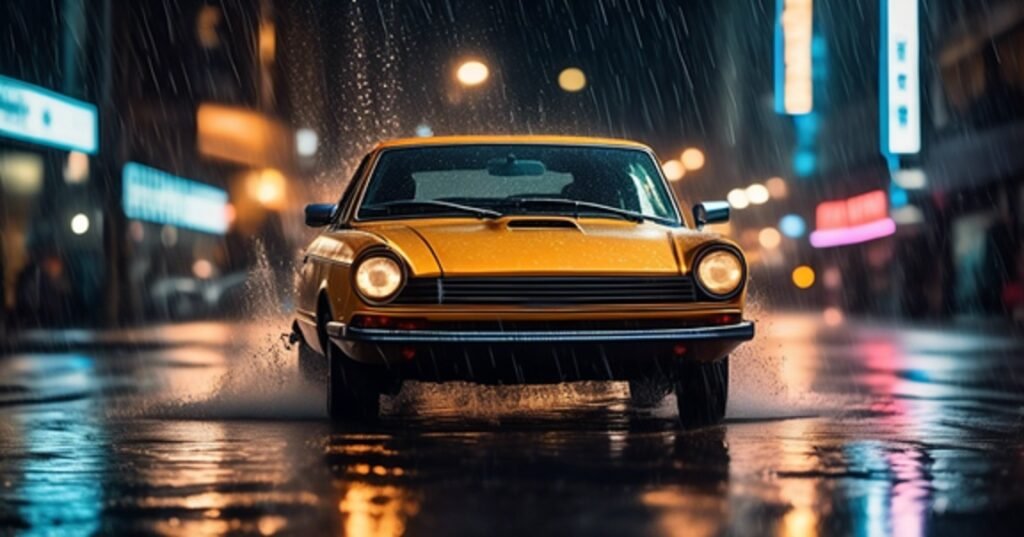Key Takeaways
- Is it safe to jump start a car in the rain?
- Park both cars on a level surface. Just make sure they’re away from any puddles to avoid electrical hazards.
- Use high-quality jumper cables with insulated handles to minimize the risk of electric shock.
- Wear rubber-soled shoes and gloves to provide another layer of safety when handling cables.
- Keep the car batteries and connections as dry as possible to prevent any electrical short circuits.
- Be aware of your surroundings and do not try to jumpstart the vehicle in lightning situations for personal safety.
Jumping a car in the rain sounds dangerous, right? You can do it pretty safely. Still, you need a few tricks up your sleeve to keep you and your car out of trouble.
First, grab some rubber gloves and a mat. They keep you dry and safe from electric shocks. Prepare your jumper cables. If you can, find a dry spot for the car’s battery.
Look for puddles around the area. Standing water isn’t your friend here.
You’ve got to remain cool and collected. Safety first, always. By following these steps, you can boost your car and avoid any shocks.
Your car comes back to life and off you go. Rain shouldn’t hold you back. You just need to know how to get started again.
Can You Jumpstart in Rain?
Jumpstarting a car in the rain is a bit tricky, but you can do it! Just take the steps and follow them to get started. Let’s break it down so you can safely and effectively do it.
Assess Safety Conditions
Before you begin, look things over and check for anything dangerous, such as standing water or high winds. These can make the area unsafe, making it harder to keep control over cables and equipment.
It’s wise to check that nothing is around the vehicles that could endanger them, such as slippery surfaces or obstacles. Keep an eye on the weather forecast, too. Sudden changes could make it riskier.
A waterproof cover over the battery area is a smart touch. It keeps everything dry and safe while you handle electrical components.
Evaluate Cable Condition
Next, take a long hard look at your jumper cables. You want to be sure they’re in tip-top shape. Check for any frays, corrosion, or damage that could lead to an electrical malfunction.
They should be clean and free of rust for a secure connection. Check the length of those cables. They have to reach both batteries without stretching.
Once you’re done, store them properly to keep them in good condition. Then it’s about preserving them until you need them the next time and keeping them working well.
Check Battery for Issues
Now, let’s talk batteries. If the dead battery is corroded or leaking, it may take more work to replace it. Check the battery voltage with a multimeter. If it’s dead or just too weak to sustain itself, check for loose connections or damaged terminals.
That can halt you from getting things started. Keep in mind, if your battery is old, it may be time to replace it. Remember, 80% of car batteries are destroyed by deep discharging, not rain.
Knowing that the vehicle voltage isn’t high enough to pose a big risk, you can safely proceed. This moisture isn’t a problem if you follow the right sequence, experts say, as does Auto Club spokesman Jeffrey Spring.
Once started, let the car run for 15-20 minutes to properly charge the battery. If it still doesn’t start, wait a few minutes, try again, or consult a mechanic.
If you’re in doubt, contact experts such as the team at Gerry Lane CDJR to prevent any damage that you might cause.

Precautions for Rainy Jumpstart
Jumpstarting a car in the rain may feel challenging. With some simple precautions, you can safely hit the road again! Before you dive in, create a checklist to ensure you’re ready.
First, turn off all electronic devices in both cars to avoid power surges. This includes things such as your car radio, headlights, and anything plugged into the car’s power outlets. Water and electricity don’t mix well, so safety is imperative. Be careful with jumper cables and electrical components in the rain at all times.
Next, consider placing the cars themselves. You want them close enough for the jumper cables to reach, but you also want to minimize rain exposure. If you can, park under a tree or in a garage. If not, maneuver the cars so that the fronts are as close as possible without touching.
Covering the battery with a waterproof tarp or blanket during the jumpstart process is smart. It protects your gear and ensures a positive start. That way, you keep the battery and the jumper cables nice and dry, which minimizes the risk of short-circuiting.
Wear Protective Gear
Safety gear is your best friend in this case. Wear waterproof gloves to keep your hands dry and safe from electric shocks. Additionally, wear waterproof clothing so you can stay comfortable and focused on the task.
Safety goggles are a good idea too, as they protect your eyes from any unexpected sparks. Non-slip shoes are crucial to prevent slips and falls on wet surfaces. Keep in mind that a solid hold can really make a difference in wet conditions.
Use an Umbrella
An umbrella is invaluable. Hold it over the battery area, keeping the towel dry while connecting the jumper cables. Make sure that the umbrella is stable and doesn’t block your path.
If the cars were parked right next to each other, a big umbrella could cover both of them. However, beware of the wind—an umbrella can become a dangerous projectile if the wind blows it about.
Keep Hood Closed Initially
When it starts to rain, keep the hood of the vehicle closed. This provides additional protection to the battery. Keep it closed until you are ready to connect the jumper cables.
Use the time with the hood down to check the other car and gather your tools. Have a clear area before you pop the hood to avoid any accidents.
It’s always smart to have a roadside emergency kit. This includes items such as blankets, flares, a first-aid kit, and tools. It is a good idea to add reflective clothing to make you more visible to other drivers, particularly when you’re operating in low light.
After the jump start, allow your vehicle to run for roughly 15-20 minutes so the battery gets charged properly. If things aren’t working, wait a few minutes with the helper vehicle running. Then, reattach the cables or consult a professional.
When in doubt, call an expert (but do your research first). Our team at Gerry Lane CDJR is here to help you avoid any potential issues.
How to Jumpstart Safely in Rain
Jumping a car in the rain? It’s safer than you might think. Experts agree that a car’s voltage isn’t high enough to give you an electric shock. Moisture shouldn’t be a problem if you do the right things. Let’s break it down into easy steps.

1. Prepare Your Vehicle
First, turn off all electronic devices in both vehicles. This prevents unnecessary power draw. Park the assisting car close enough so that the jumper cables reach without a strain.
Make sure both vehicles are on level ground and stable, using parking brakes so they won’t roll away. Cover the battery area of the dead car with water-resistant material to keep it dry. If it’s dark or the rain is heavy, have a flashlight handy to light up the area.
2. Connect Jumper Cables Correctly
Now, let’s talk about the cables. First, attach the red clamp to the dead battery’s positive terminal. Hook the other end of the red cable to the working battery’s positive terminal.
Then, attach one end of the black cable to the working battery’s negative terminal. Secure the other end to an unpainted metal surface on the dead vehicle. Do not allow the cables to touch, as it may cause sparks. Check everything one last time before moving on.
3. Start the Working Vehicle
Fire up the vehicle with the healthy battery. Let it run a few minutes to help recharge the dead battery. Listen out for sparking or strange sounds.
I leave the hood open for better ventilation. Be prepared to reposition the cables if necessary to achieve a secure connection.
4. Start Your Vehicle
After a few minutes, attempt to start the dead car. Listen for any weird sounds that might indicate other issues are present. If it doesn’t start after a few tries, you may need professional help.
Once it’s running, let it idle for a few minutes to stabilize the battery.
5. Disconnect Cables Safely
When it’s time to disconnect, go in reverse order. When finished, take the black cable off the dead car first, then the working car. Now, remove the red cable.
Ensure the clamps don’t touch each other to prevent sparking. Put the cables away for next time, and examine the battery terminals for signs of corrosion or damage.
6. Inspect Battery Post-Jumpstart
Finally, examine the dead battery for any signs of repair or continued malfunctions. Over the next couple of days, monitor the vehicle’s performance.
You may want to use a multimeter to test the battery’s health. Regularly check your tanks for leaks or corrosion. Keep in mind that around 70% of battery failures are due to corrosion; corrosion tends to amplify in wet weather.
Potential Risks and Dangers
It’s risky to jump-start a car in the rain. It’s sometimes necessary if your battery dies at an inconvenient time. So let’s go through the potential hazards so you know how to prepare if you ever find yourself in this situation.
Risk of Electrocution
When using jumper cables in wet conditions, the risk of electrocution is real. Symptoms of electric shock include tingling, numbness, or muscle spasms. If you or someone else experiences this, get medical attention immediately.
It’s also important to avoid direct contact with wet surfaces when using jumper cables. Make sure your cables are in tip-top shape to decrease the risk of electrical hazards. Stay on your toes and keep looking in case there’s something conductive around. Safety needs to be a priority when working with electricity in the rain.
Dangers of DIY Jumpstarting
If you have no experience, you can easily make mistakes while jumpstarting a car that may become expensive. Inexperienced people may screw up their vehicle’s electrical system. Jumper cables used incorrectly can cause sparks—and fires.
Some car parts can be particularly sensitive to incorrect jumpstarting. If in doubt, it’s smart to call for roadside assistance. Sometimes it’s just safer to have an expert on hand than risk damaging your car or worse.
Common Car Issues in Wet Conditions
Rainy weather can exacerbate existing battery issues or even create new ones. Moisture can cause corrosion on battery terminals, which can affect performance. Wet roads can make it tricky to handle your vehicle safely when jumpstarting.
If it’s raining cats and dogs, that’s your opportunity to bring your battery in and get it checked or replaced. It’s also smart to be prepared with a standalone roadside emergency kit. Keep tools, jumper cables, and a first-aid kit in your trunk.
Remember, if your car still won’t start, wait a bit, then try again or call a mechanic. In rainy scenarios, making sure to have proper connections and keeping water at bay is important to avoid electrical shock.
When in doubt, turn to experts like those at Gerry Lane CDJR to avoid damage. A little caution can go a long way in keeping both you and your car safe.
Additional Safety Tips
Jumpstarting a car in the rain does require additional caution. First, collect a list of safety tips that are easy to understand. You and anyone helping should know these measures before starting.
Keep a first aid kit nearby for small boo-boos. It’s wise to stay a safe distance from the cars throughout the entire process. This keeps everyone out of trouble if cables slip or sparks fly.
Wear Gloves During Process
Insulated gloves are essential. They protect you from electric shocks. Check that your gloves are dry, as wet gloves can make it difficult to grip your things, and grip is important when handling cables.
Choose gloves that cover well to avoid any skin contact with battery acid, which can cause burns. If you see any rips or tears in your gloves, throw them out and grab a new pair. Damaged gloves won’t protect you like they should.
Seek Professional Assistance
If jumpstarting doesn’t work after a few tries, call in the pros. Sometimes, a battery issue requires a technician to look at it. Having roadside assistance can be a lifesaver, especially in bad weather.
Have numbers for mechanics or services available. A quick call to Gerry Lane CDJR or other professionals can help avoid damage to your vehicle and keep everyone safe.
Preventive Measures for Wet Weather
Prepare before the rain hits. Check your battery regularly and swap out old ones before they fail. Store jumper cables and emergency gear in a waterproof box for easy access.
A flashlight and reflective clothing are also handy—both help you be seen and work better at night. Prepare for inclement weather with a roadside emergency kit.
Things like blankets, flares, and a first-aid kit can help improve a bad situation. Keep in mind that up to 80% of breakdowns can be eliminated with routine car care.
Frequently Asked Questions
Can you jumpstart a car in the rain?
Yes, you can jumpstart a car in the rain. Be careful to make it safe, too. Use insulated tools and watch out for standing in puddles. Read and follow all safety instructions.
What precautions should I take when jumpstarting in the rain?
Wear rubber gloves and rubber-soled shoes. Keep the cables dry and don’t touch any metal parts. You want to make sure that vehicles aren’t parked in water. Safety first!
Is it safe to jumpstart a car during a thunderstorm?
No, it’s unsafe. Wait for the storm to pass. Lightning is dangerous for you and your car. Safety does come first.
What are the potential risks of jumpstarting in the rain?
Water shorts out electricity. It’s easier to make a mistake when things aren’t visible. Take measures to reduce these risks as much as you can. First and foremost, be safe.
How can I jumpstart a car safely in the rain?
Make sure the connections are dry and insulated. Use a waterproof jacket. Then follow standard jumpstarting procedures. Safety equipment can help ease the risks.
Are there any additional safety tips for jumpstarting in the rain?
Always read your car’s manual. Track weather conditions. Use a portable jump starter, if you can. Be prepared and prioritize safety.
Can using a portable jump starter be safer in the rain?
Yes, it’s often safer. Portable jump starters reduce exposure to elements. Follow manufacturer instructions for optimal safety. Choose a quality product for reliability.
Conclusion
Jumping a car in the rain? Yes, you can do that too. Rain may sound tricky, but follow the steps and you’re set.
Follow the basics: dry your hands, check the cables, and keep safe. Don’t worry about it. Just keep in mind, safety beats speed. Gear up with the right tools, stay dry, and keep your cool.
Have a question or tips to share? Let us know! Your input helps everyone. Now, the next time the rain pours, you’ll know what to do. Ready to start jumping with your own confidence and ease? I say go for it!
Also Read: Best Car Windshield Sun Shade

Rakib Sarwar is an experienced blogger and avid automotive enthusiast with a passion for both cars and motorcycles. With years of industry knowledge, he covers everything from in-depth vehicle and bike reviews to the latest trends, maintenance tips, and cutting-edge technology. Rakib’s blog has become a trusted resource for readers who share his love for all things on wheels, offering them engaging and reliable content that fuels their automotive interests.








